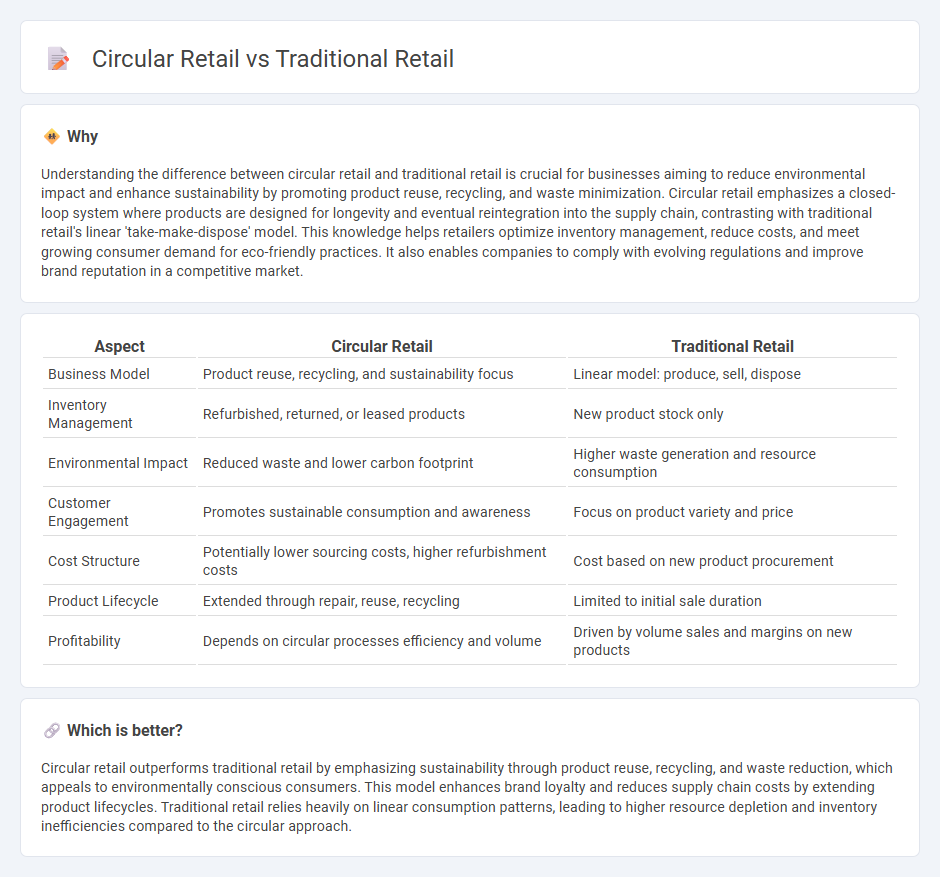
Circular retail prioritizes sustainability by promoting product reuse, recycling, and waste reduction, contrasting with traditional retail's focus on linear consumption and single-use sales models. This approach not only minimizes environmental impact but also creates new value streams through refurbishment and resale. Explore how circular retail is reshaping consumer behaviors and supply chain strategies.
Why it is important
Understanding the difference between circular retail and traditional retail is crucial for businesses aiming to reduce environmental impact and enhance sustainability by promoting product reuse, recycling, and waste minimization. Circular retail emphasizes a closed-loop system where products are designed for longevity and eventual reintegration into the supply chain, contrasting with traditional retail's linear 'take-make-dispose' model. This knowledge helps retailers optimize inventory management, reduce costs, and meet growing consumer demand for eco-friendly practices. It also enables companies to comply with evolving regulations and improve brand reputation in a competitive market.
Comparison Table
| Aspect | Circular Retail | Traditional Retail |
|---|---|---|
| Business Model | Product reuse, recycling, and sustainability focus | Linear model: produce, sell, dispose |
| Inventory Management | Refurbished, returned, or leased products | New product stock only |
| Environmental Impact | Reduced waste and lower carbon footprint | Higher waste generation and resource consumption |
| Customer Engagement | Promotes sustainable consumption and awareness | Focus on product variety and price |
| Cost Structure | Potentially lower sourcing costs, higher refurbishment costs | Cost based on new product procurement |
| Product Lifecycle | Extended through repair, reuse, recycling | Limited to initial sale duration |
| Profitability | Depends on circular processes efficiency and volume | Driven by volume sales and margins on new products |
Which is better?
Circular retail outperforms traditional retail by emphasizing sustainability through product reuse, recycling, and waste reduction, which appeals to environmentally conscious consumers. This model enhances brand loyalty and reduces supply chain costs by extending product lifecycles. Traditional retail relies heavily on linear consumption patterns, leading to higher resource depletion and inventory inefficiencies compared to the circular approach.
Connection
Circular retail and traditional retail intersect through their shared goal of product distribution to consumers, yet circular retail emphasizes sustainability by integrating product reuse, recycling, and waste reduction into the supply chain. Traditional retail relies on linear models of production and consumption, whereas circular retail promotes a closed-loop system, extending product lifecycles and minimizing environmental impact. This connection drives innovation in inventory management and consumer engagement strategies, blending profitability with ecological responsibility.
Key Terms
Linear Supply Chain
Traditional retail relies heavily on a linear supply chain model characterized by a sequence of production, distribution, consumption, and disposal. This approach often leads to increased waste and resource depletion due to the lack of product lifecycle extension and recycling. Explore how shifting to circular retail can transform supply chains for sustainability and efficiency.
Product Lifecycle Extension
Traditional retail often leads to shorter product lifecycles due to a linear sales model that prioritizes new purchases over reuse, repair, or recycling. Circular retail emphasizes product lifecycle extension by incorporating practices like remanufacturing, resale, and refurbishment, promoting sustainability and reducing waste. Explore how circular retail can revolutionize your business and support environmental goals.
Reverse Logistics
Reverse logistics plays a critical role in circular retail by efficiently managing product returns, refurbishments, and recycling, reducing waste and extending product life cycles. In contrast, traditional retail often treats returns as losses or disposal opportunities, lacking systematic processes for reintegrating products into the supply chain. Explore how optimizing reverse logistics in circular retail enhances sustainability and profitability.
Source and External Links
Direct to Customer vs. Traditional Retail Business Model - Traditional retail involves selling products through intermediaries such as wholesalers and retailers, with physical stores managing inventory and customer interactions, benefiting from established distribution channels but limited direct consumer engagement.
Retail vs. E-commerce: What's the Difference? | Indeed.com - Traditional retail operates through physical storefronts allowing direct customer interaction and immediate product access, offering advantages like hands-on experience and minimal shipping costs.
The Fall of Traditional Retail Commerce | Nexcess - Traditional retail evolved from 19th-century mom-and-pop shops to department stores, malls, and big-box stores like Walmart, but has been challenged by the rise of e-commerce and digital innovations.
 dowidth.com
dowidth.com